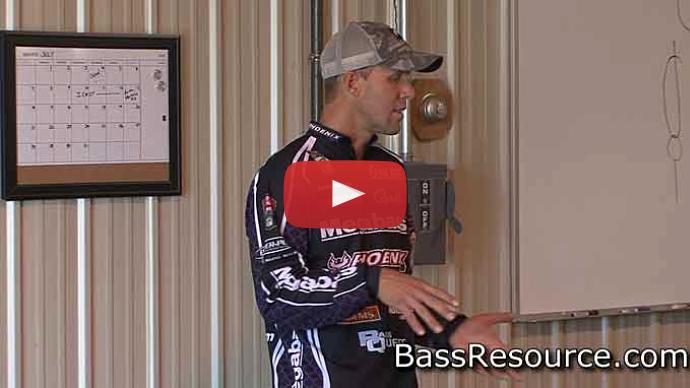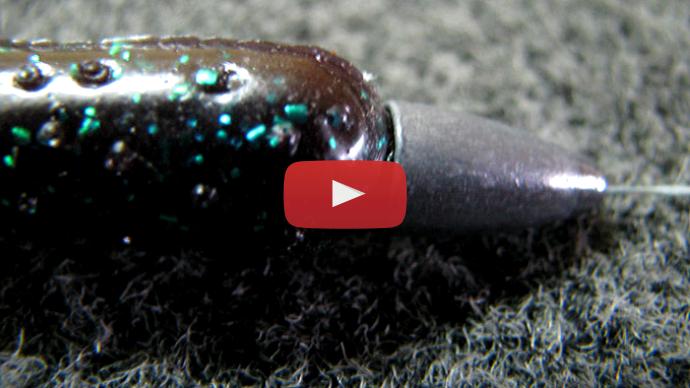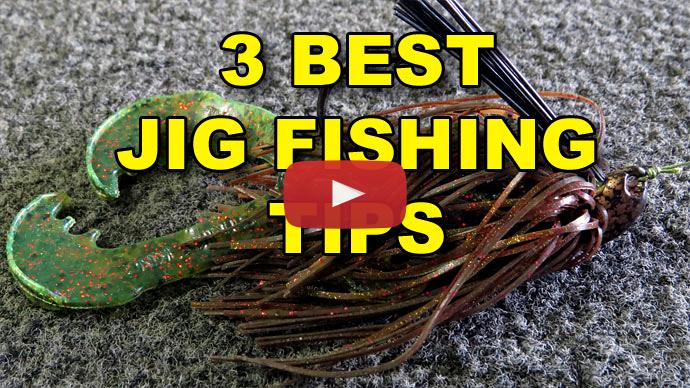Hey, folks, Glenn May here with BassResource.com. And today I wanna talk to you about using the different kind of weights for bass fishing. A lot of the questions we get on our forums are from people who wanna know, like, "How much weight can I use on a Texas rig," or, "How much weight should I use for jig?" And a lot of times the answers that you see are, "The lightest I can get away with." What? What is that supposed to mean? Right. Can you elaborate a little bit? Yeah. So that's what I'm gonna talk about today. I'm gonna help you figure that out.
Typically, you know, "The lightest so I can get away with" is another way of saying, "It depends." And that really is the answer because there's several different variables that influence how much weight you're gonna use on a Texas rig or on a jig. And that's what I wanna get into today.
Specifically, I've narrowed it down to six different variables that interact together that's gonna determine how much weight you use.
Before I get into those don't skip this part. There's a foundational piece that you need to understand that if you don't get this, the rest of what I'm gonna say for the rest of the video, isn't gonna make any sense. So let me get right into it.
As a general rule, the slower the fall the lure, the more bites you're gonna get. Okay, as a general rule, there are exceptions. And I'm gonna get into that in a minute, but typically you get more bites, the slower the rate of the fall of the lure through the water column. So your object of the game here is to get a slow fall while still getting the action of the bait that you need.
Some baits, you can throw a completely weightless and they just look like a piece of garbage in the water. Say a large brush hog, for example. You throw that weightless and it just sits there and kind of falls in the water and there's no action to it. It doesn't look alive. So it has to look at least alive, like, it's something swimming in the water column. So you need at least a little bit of weight on most of these lures to give you that kind of action.
So with that in mind, slow rate of fall while making the bait look alive. Here's the six things that can affect how much weight you use. In no priority order here, it's the cover you're fishing, the depth of the water that you're fishing in, how much wind you have, the bulk of the lure, current and the disposition of the fish. So let me dive into that.
First of all, it's the cover you're fishing in. If you're throwing the lure out in... By the way, I'm gonna get into my recommendations here too, in the video, just so you know it's coming. But if you're throwing the lure out in open water and you know, falls nice and slow the way you want it to. Great. But once you throw it into cover, say lily pads, hydrilla, milfoil, or you're throwing it into bushes and, you're pitching and flipping into flooded bushes. Once that line starts to drape over the weeds, that adds another layer of, you know, some friction. And if you're using too light of a weight, a lot of times the lily will just hang. It won't even go, it won't penetrate the cover. It won't fall. The line will just drape over that lily pad and the lure will fall down as much as the underline will let it, and then just hang off the lily pad.
So you need to add some more weight in order to keep that lure following through the water column, despite the cover that's trying to go through. So that's one thing, the thicker the cover it is the more weight you're gonna end up using.
Second is the water depth. So typically you're fishing less than 10 or 12 feet. You can let it fall slowly through that whole water column. And you're apt to get bit anytime during that fall. But if you're fishing deeper, 15 to 20 feet, or even deeper than that, a lot of times the fish are down at the bottom, unless they're suspending. Sometimes they'll be out in 40 50 feet of water suspending like within 5 feet, 10 feet of the surface. So you can let it fall real slow. But if they're sitting on the bottom, when it's deep, you're gonna spend a lot of time waiting for that lure to reach the bottom.
So how much weight you use? You wanna add some more weight to get it down to the bottom, but it depends on what your presentation is gonna be once it gets on the bottom.
If you're just dragging it on the bottom, which is very common, then you can use heavier weight. Because you don't worry about hopping and picking it up off the bottom. But if you want to work and lift it up off the bottom, let it fall back down and give it a slow flutter. Then you kind of have to balance like how much weight to put on that you're gonna wait getting it down to the bottom versus how slow of a fall you're gonna get by lifting and dropping it once it gets to the bottom.
I don't like to waste my time all day fishing, waiting for the lure to drop.With every cast, you're waiting it to drop 20 feet, 25 feet. That takes up a lot of time during the course of the day. And a lot of time, you're not, the lure is not in the strike zone. So I'll use a heavier weight to get it down there. So light enough where I can still work it and get those bites. You just gotta figure out that balance is supposed to be. If it's sitting on the bottom all the time, you dragging it, then it's not so much of a difficult choice.
The third thing is wind. Wind. Here's the thing. If you're fishing a real light lure and you cast it over to your target, you make a great cast. It gets right to where you want it to be. The wind can grab that line and pull that lure away from the strike zone before it even has a chance to fall through the water column.
Worse yet, if it's a stronger wind, it makes casting difficult, a light lure, if the wind's blowing this way, you throw it here and it catches it and [vocalization] it puts it over here. Right? I was trying to reach here, but the wind put it over there. So that's a problem.
Plus, a lot of these lures, jigs and Texas rigs especially, when you're working them on the bottom, you're looking for subtleties. You're feeling everything down there. If it's a hard bottom, a soft bottom, if there's rocks, weeds, you know, sticks, anything like that. Plus the pickup, the bite on these can be really, really light. You're working the lure on the bottom and suddenly it gets light. You just, you lose weight. Now that's a fish that just picked it up. Or maybe you're throwing a 1/4 ounce weight lure and now it weighs 3/8 ounce. Okay. That could be a fish that grabbed it.
Well, if it's windy out, you could have a lure on the bottom, but then the wind grabs that line and it picks that lure up. And you've been feeling this lure all the time and suddenly it's weightless. You don't know whether is that a fish or is that because the wind grabbed the line. Right? And it's a lot more difficult to feel those things on the bottom when the wind is grabbing your line. And especially with your lure is really light.
So you need to add more weight to compensate for what the wind is doing. The more weight you have, the more contact that you have, the better feel you have with that bait. And you'll be able to feel that the things on the bottom and you're gonna be able to feel bites a little bit better. So plus you're casting, you know, you won't have that lure swept away by the wind before it gets to where you're casting to you a little bit heavier weight, a little bit heavier lure, you'll be able to cast it to that target easier in the wind. So you gotta gauge how much weight you're gonna add, depending on how strong the wind is.
Now, the fourth thing is how bulky your lure is. The bulkier the lure is the more it displaces water so the slower it falls. So large jigs or jigs with a lot of strands on the skirt with a big bulky trailer on it will fall slowly through the water column. Same with a big creature bait with a lot of appendages on it that flap around in the water, you know, that slows the fall rate of the bait. A thinner profile lure, say for example, a finesse worm or just even a ribbon tail worm will fall through the water column a lot faster.
So a 1/4 ounce weight, isn't a 1/4 ounce weight. Isn't a 1/4 ounce weight, depending on what you're throwing. A 1/4 ounce, bulky creature bait will fall slowly through the water column whereas the same 1/4 ounce on a finesse worm with no appendages, it's basically a stick of plastic, will go [vocalization] right through the water column. It'll shoot right down to the bottom, skyrocket right on down there. So when someone says, "Oh, I was using a 1/4 ounce such-and-such," you know, you got to think about the bait that they, how much bulk it is. Because that's gonna make a big difference on how slow that, or how fast, either way, that bait falls through the water column. It makes a big, big difference.
Okay. So the next one is current. I'm talking mostly about rivers and creeks and things like that, but also it can be wind generated current. But if we're talking about wind generated current, we're already dealing with wind, like I talked about earlier. But it's very much the same principles apply to it as wind with a couple of things to keep in mind.
With current, yeah, you always have to heavy up a little bit more, add more weight because you have to compensate for the current, the stronger, the current, the more weight you need to use.
But if you use too much weight, a lot of times it'll get down to the bottom. The current will sweep that bait right up into a rock, under a crevice. And it's gonna be hard to get it out. It'll lodge it right in there. So you have to keep in mind that, yeah, you want the lure to slowly fall through the water column, but not so slow that it's gonna be swept downstream before it gets, you know, to your target or before it actually can go through the strike zone where the fish are at. At the same time, you don't want it so heavy that it sinks to the bottom and then it gets stuck. So how do you figure this out?
Here's the rule of thumb I like to use when I'm fishing in rivers and streams. If I'm using a light enough lure where it reaches the bottom. And if I cast up here, the currents going down here, when I say reached the bottom, doesn't mean I cast here and it finally reaches the bottom here. It reaches the bottom probably about here or so. It gets through the water column fairly quick, but it's light enough. So once it hits the bottom, the current will still push the lure long. Okay. The lure will still just bounce along in the bottom real lightly, just kind of skipping along the bottom. That's kind of how I wanna use it.
So the current is making it actually still...it looks like something that's alive, that's a little helpless. Which is, you know, bass will target that too. But that way won't get stuck. Okay? It's not gonna get wedged into a rock or wedged into something, a stick or stump or something down underneath, and you won't get hung up as much. That to me is about the right amount of weight to use.
And then all depends on how much current I've used anywhere from a 1/4 ounce weight, up to almost an ounce. In heavy, heavy, current, you're using 3/4 ounce or more heavy weight. I would argue almost that it's hard to catch fish and bass, especially in that stronger current, but that's another story. But I've done it and it's been the right amount of weight with a heavy weight like that for it to bounce along the bottom, because it's, the current is so strong. You use that same 3/4 ounce weight in a slow moving current. You're gonna get stuck every time on the bottom. Plus the Lure is just gonna go [vocalization] right down to the bottom. Bass won't have a chance to bite it.
Now the sixth variable is the disposition of the bass. And this is where we start to get to some exceptions to what I just told you about.
Bass typically like to bite a lower, the slower it falls. It looks like something helpless, it's something slow enough where they can hit it, where it's not gonna dart away from them. You get more bites.
That said, there are times when that's too slow. It gives them too much time to examine the bite...the bait. It gives them too much time and they see it's unnatural and they don't bite it. So you need to give them more of a reaction strike. And that's when you add more weight to it. Let it fall through the water column faster.
Doesn't happen all the time. But I've noticed if I'm using really slow moving baits, I'm not getting a lot of bites. Then I'll start to add more weight to it and let it fall through the water column faster. And sometimes I'll get more strikes that way. The bass doesn't have time to examine it. It's falling, they need to react to it right now or let it go. And so it's a quick decision and you get more bites sometimes that way.
So the disposition will play a factor with, well, all these, all these things I just mentioned, they're kind of intertwined, right? It gets confusing. This is why people say, "The lightest I can get away with." Right. "It depends." Right?
If you got wind going this way and current going this way, and you've got cover that you're throwing in. Right. Now, you've got these multiple variables, plus trying to figure out what the disposition of the bass is. You can see this gets kind of confusing as to what to use.
So here's my general, my recommendation. As a general rule, a 1/4 ounce and 3/8 ounce weights are gonna be your go-to baits most of the time...or weights, most of the time. If you're starting out bass fishing and you're new to all this, get 1/4 ounce bullet sinkers, 1/4 ounce weights, 3/8 ounce weights, 3/8 ounce jigs, that kind of stuff. That's gonna be your bread and butter most of the time.
Then you can start to fill out the rest of your tackle box on each end of the spectrum, and you'll have the whole gamut. Then you'll be ready to go. At least from the, you know, the 1/8 ounce to 1/2 ounce. That's gonna cover 98%, 95% of your fishing.
It's the heavier weights and the much lighter weights are more unique circumstances that you don't come across too often, but you still need them. You know, if you're fishing heavy matted vegetation, like the hydrilla and the milfoil, they formed this thick canopy, and you gotta be able to penetrate through that. Then you're gonna need to use a heavier weight to get through that. Conversely, if you're fishing real ultralight gear and you wanna get that real light bite, and you're using two pound test or four pound test line, then you can go, you know, with a one 1/16th ounce weight, you know, something like that, 3/32nd. But those are extremes. 1/4 ounce, 3/8 ounce pretty much is gonna set you up for success. So I hope that helps. For more tips and tricks like this visit BassResource.com.



